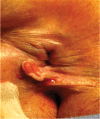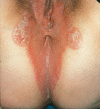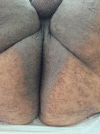Systemic and Autoimmune Diseases
- PMID: 31507347
- PMCID: PMC6731114
- DOI: 10.1055/s-0039-1687833
Systemic and Autoimmune Diseases
Abstract
This article reviews the clinical features of systemic and autoimmune diseases affecting the perianal region and its surrounding integumentary structures.
Keywords: acanthosis nigricans; glucagonoma syndrome; leukemic infiltration; pemphigus vulgaris; psoriasis; pyoderma gangrenosum; vitiligo.
Conflict of interest statement
Figures







References
-
- Bystryn J C, Grando S A. A novel explanation for acantholysis in pemphigus vulgaris: the basal cell shrinkage hypothesis. J Am Acad Dermatol. 2006;54(03):513–516. - PubMed
-
- Malik M, El Tal A E, Ahmed A R. Anal involvement in pemphigus vulgaris. Dis Colon Rectum. 2006;49(04):500–506. - PubMed
-
- Vallini V, Andreini R, Bonadio A. Pyoderma gangrenosum: a current problem as much as an unknown one. Int J Low Extrem Wounds. 2017;16(03):191–201. - PubMed

